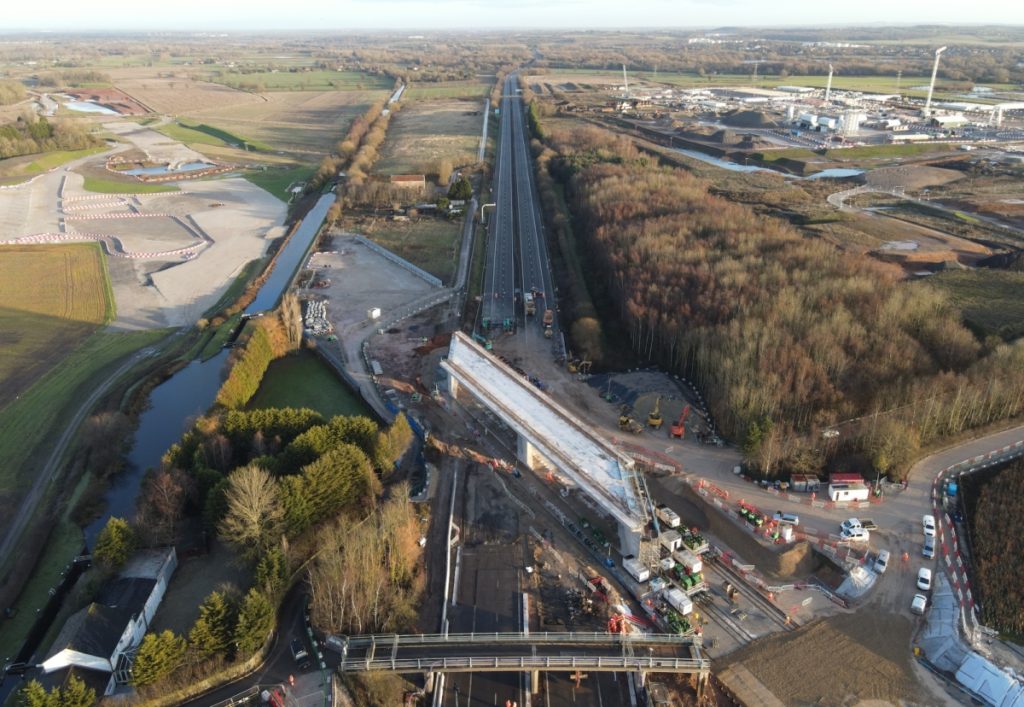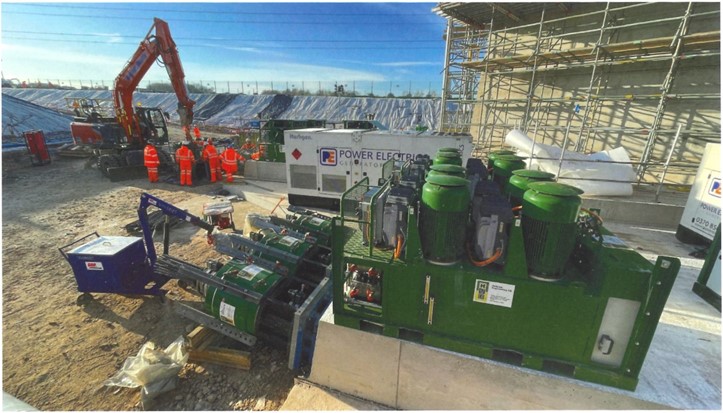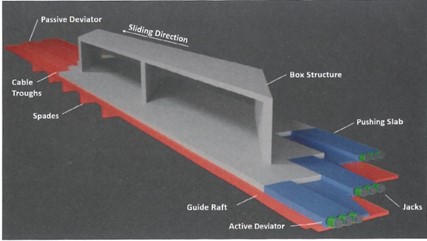A 165m-long, 12,600t box slide across a major expressway has been successfully carried out thanks to an integrated project-team approach, writes Freyssinet’s Sales Director (Industry & Energy) Kevin Bennett
The HS2 high-speed rail line being built from London to northwest England is the largest infrastructure project in Europe and the UK’s most important economic and social regeneration project in decades. By the early 2030s, HS2 will begin running initial high-speed services connecting super-hub stations at Old Oak Common in London and Birmingham Curzon Street in the Midlands.
Major civil engineering works are now under way on Phase 1, London to Birmingham. with over 350 active sites and US$29 billion contracted into the supply chain.
Near Marston, to the north-east of Birmingham, HS2 must cross over two existing transport routes, the M42 expressway and the Birmingham and Fazeley Canal. A 250m-long multi-span structure is under construction. the first part of which is the expressway crossing.
The baseline design for the M42 structure consisted of a large portal frame on piles. an option that needed two years of reduced lane widths and three months of overnight closures of the expressway. Main contractor Balfour Beatty Vinci (BBV) searched for a better method and, with Freyssinet, developed a box-slide alternative which would be far safer for workers and drivers, with much less work taking place alongside the live expressway.
The main advantage was that the whole structure could be constructed to one side of the road, well away from the traffic. During a ten-day closure, the box would be pushed across the expressway using jacks pulling on cables which would be anchored close to the expressway.
There were sustainability benefits related to the alternative too. As the bridge would be pushed into position, it was vital to limit its weight through a reduction in concrete volume, equating to a reduction in embodied carbon of 30%.
The new bridge design features a two-cell box consisting of a large base slab, three broad piers and a top deck. As the geometry required a highly skewed crossing of 61° , the structure is unusually long.
While the initial concept was to build the box adjacent to the motorway, as is normal, there were difficulties associated with diverting a high-voltage electrical cable as well as with closing the Marston Lane access road. Both of these crossed the construction area. and a change of plans was required.
As a result, BBV explored the option of going back to the original baseline design, but in the meantime Freyssinet revisited its standard Autoripage sliding method so that the box could be built 80m away from the edge of the motorway.
The Autoripage technique consists of completely clearing the ground and sliding the structure on bentonite grout using Hebetec 1,000-tonne jacks. Once the sliding is complete, backfilling takes place in order to open a route to traffic.
The revised sliding method aimed to allow BBV the time needed to implement the power-cable and access-road diversions whilst the box was being constructed. This was an important consideration because any delay would set back the project by 12 months, as the road could only be closed over the Christmas/New Year period. The 85m length of the box combined with the 80m offset meant that such an operation would be the world’s longest box slide distance, at 165m.
However, there were some concerns associated with the alternative construction method. Firstly, there was the potential to lose accuracy in the left-right steering of the box as it crossed the 80m distance and traversed across the motorway.
A secondary concern involved the construction of the guide raft, which is usually a similar size to the box that it supports but, in Marston, was twice as long as the box. And its exposed part – between the box and the M42 – could not be constructed until the cable and access bridge had been diverted. Furthermore, the Autoripage cables that run along the entire length of the raft could not be laid out until the entire raft was constructed.
The programme dictated that the part of the guide raft beneath the footprint of the box should be completed in early 2022 so that the bridge could be built on top through that summer and autumn. The land between the box and the expressway, however, could not be cleared of the power cable and the access road until much later that year.
A way had to be found to build the guide raft in two separate phases, and one where the Autoripage cables could be inserted beneath the box after its construction. This was critical because extending the guide raft and building the box 80m further away from the road was the key innovation that persuaded BBV to keep the construction method as a box slide.
The guide raft design consisted of concrete upstands along both its sides which, as the box pushed forwards, provided the left-right directional control. The system used nine 52-strand Autoripage cables anchored at the end of the guide raft closest to the road. These ran the full length of the guide raft, passing underneath the box and terminating in an active deviator cast into a push-slab extending out from the base of the box. Nine 1,000t jacks were attached to the cables at these active deviators.
As alluded to, the requirement to cast the guide raft in two separate phases meant that the standard method of installing the cables prior to box construction could not be implemented because the last 80m of each cable would have nowhere to be laid out on. To get around this issue, a new method was devised to allow the strands to be installed after box construction.
The innovative solution consisted of the casting of nine troughs along the full length of the guide raft. accommodating the end of the active deviator, which consisted of a metal tube large enough to enclose the 52-strand cable. In this way, as the box progressed on the raft towards the expressway, the deviator tube could then travel along the trough, guiding the strands out of the trough, through the deviator, and into the jack pulling on the cable.
The third innovation implemented was the use of winching methodology commonly used in stay cable erection, which was adapted for the installation of the strands beneath the box.
Two winches, one at each end of the trough, were used to pull the winch wire back and forth. Each new prestressing strand could be attached to the winch wire via a specially developed strand connector that allowed it to be pulled into the trough without twisting around the other strands. The system worked well and was even adapted to enable two strands to be installed at a time, increasing productivity from two shifts per cable to less than one.
The design and delivery of this operation took over two years of close work between the Freyssinet Group companies Freyssinet UK, GPCM and Hebetec.
As the slide date approached, the overall project team as well as the client and other stakeholders came together in a concerted push to resolve last-minute problems that could delay the slide until the end of the following year.
Daily coordination meetings critically reviewed progress and developed solutions to overcome upcoming problems in a highly transparent, dynamic and collaborative way. It was an excellent example of how a truly integrated project team can have a huge influence on the successful outcome of the works.
The extra-long guide raft worked perfectly. Normally, the box slides straight off the raft and across the prepared and levelled excavated area. On Marston, the box travelled the initial 80m whilst the south-bound carriageway was being excavated. By the time the box reached the hard shoulder, the ground was ready so the slide could continue. When the box had reached the central reservation, the northbound side had been excavated.
The structure took 36 hours to slide the record 165m distance, four hours ahead of schedule and without any health and safety incidents.
This article was in the August 2023 edition of BD&E magazine



